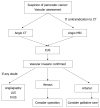Vascular invasion in pancreatic cancer: Imaging modalities, preoperative diagnosis and surgical management
- PMID: 20143460
- PMCID: PMC2825328
- DOI: 10.3748/wjg.v16.i7.818
Vascular invasion in pancreatic cancer: Imaging modalities, preoperative diagnosis and surgical management
Abstract
Pancreatic cancer is associated with a poor prognosis, and surgical resection remains the only chance for curative therapy. In the absence of metastatic disease, which would preclude resection, assessment of vascular invasion is an important parameter for determining resectability of pancreatic cancer. A frequent error is to misdiagnose an involved major vessel. Obviously, surgical exploration with pathological examination remains the "gold standard" in terms of evaluation of resectability, especially from the point of view of vascular involvement. However, current imaging modalities have improved and allow detection of vascular invasion with more accuracy. A venous resection in pancreatic cancer is a feasible technique and relatively reliable. Nevertheless, a survival benefit is not achieved by curative resection in patients with pancreatic cancer and vascular invasion. Although the discovery of an arterial invasion during the operation might require an aggressive management, discovery before the operation should be considered as a contraindication. Detection of vascular invasion remains one of the most important challenges in pancreatic surgery. The aim of this article is to provide a complete review of the different imaging modalities in the detection of vascular invasion in pancreatic cancer.
Figures
Similar articles
-
Escalating computed tomography angiogram (CTA) grade predicts unresectability and margin status for pancreaticobiliary neoplasms.HPB (Oxford). 2010 Mar;12(2):115-22. doi: 10.1111/j.1477-2574.2009.00145.x. HPB (Oxford). 2010. PMID: 20495655 Free PMC article.
-
Endosonography is superior to angiography in the preoperative assessment of vascular involvement among patients with pancreatic carcinoma.J Clin Gastroenterol. 2001 Jan;32(1):54-8. doi: 10.1097/00004836-200101000-00013. J Clin Gastroenterol. 2001. PMID: 11154172
-
Pretherapeutic evaluation of patients with upper gastrointestinal tract cancer using endoscopic and laparoscopic ultrasonography.Dan Med J. 2012 Dec;59(12):B4568. Dan Med J. 2012. PMID: 23290296 Review.
-
[MRI in the evaluation of peripancreatic vessel invasion and resectability of pancreatic carcinoma].Zhonghua Zhong Liu Za Zhi. 2007 Nov;29(11):846-9. Zhonghua Zhong Liu Za Zhi. 2007. PMID: 18396644 Chinese.
-
Surgery for Pancreatic Cancer.Hematol Oncol Clin North Am. 2015 Aug;29(4):701-16. doi: 10.1016/j.hoc.2015.04.001. Epub 2015 May 30. Hematol Oncol Clin North Am. 2015. PMID: 26226905 Review.
Cited by
-
Multidisciplinary management of locally advanced-borderline resectable adenocarcinoma of the head of the pancreas.Clin Transl Oncol. 2013 Mar;15(3):173-81. doi: 10.1007/s12094-012-0962-4. Epub 2012 Nov 21. Clin Transl Oncol. 2013. PMID: 23180346 Review.
-
Dual-Frequency Piezoelectric Endoscopic Transducer for Imaging Vascular Invasion in Pancreatic Cancer.IEEE Trans Ultrason Ferroelectr Freq Control. 2017 Jul;64(7):1078-1086. doi: 10.1109/TUFFC.2017.2702010. Epub 2017 May 8. IEEE Trans Ultrason Ferroelectr Freq Control. 2017. PMID: 28489536 Free PMC article.
-
Use of imaging as staging and surgical planning for pancreatic surgery.Hepatobiliary Surg Nutr. 2020 Oct;9(5):603-614. doi: 10.21037/hbsn.2019.05.04. Hepatobiliary Surg Nutr. 2020. PMID: 33163511 Free PMC article. Review.
-
A tumour score with multidetector spiral CT for venous infiltration in pancreatic cancer: influence on borderline resectable.Radiol Med. 2014 May;119(5):334-42. doi: 10.1007/s11547-013-0349-9. Epub 2014 Mar 12. Radiol Med. 2014. PMID: 24619824
-
Pancreatic adenocarcinoma: Outstanding problems.World J Gastrointest Surg. 2012 May 27;4(5):104-13. doi: 10.4240/wjgs.v4.i5.104. World J Gastrointest Surg. 2012. PMID: 22655124 Free PMC article.
References
-
- Warshaw AL, Fernández-del Castillo C. Pancreatic carcinoma. N Engl J Med. 1992;326:455–465. - PubMed
-
- Wagner M, Redaelli C, Lietz M, Seiler CA, Friess H, Büchler MW. Curative resection is the single most important factor determining outcome in patients with pancreatic adenocarcinoma. Br J Surg. 2004;91:586–594. - PubMed
-
- Ahmad NA, Kochman ML, Lewis JD, Kadish S, Morris JB, Rosato EF, Ginsberg GG. Endosonography is superior to angiography in the preoperative assessment of vascular involvement among patients with pancreatic carcinoma. J Clin Gastroenterol. 2001;32:54–58. - PubMed
Publication types
MeSH terms
LinkOut - more resources
Full Text Sources
Medical


